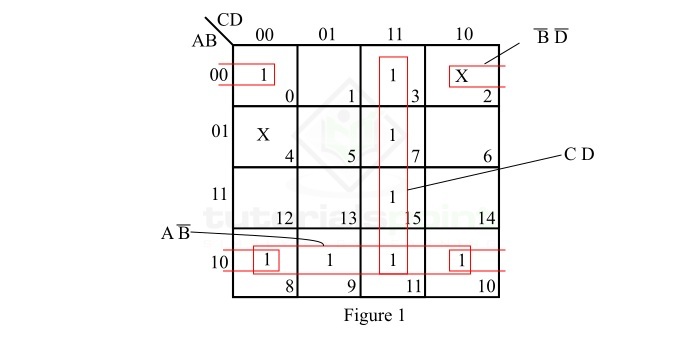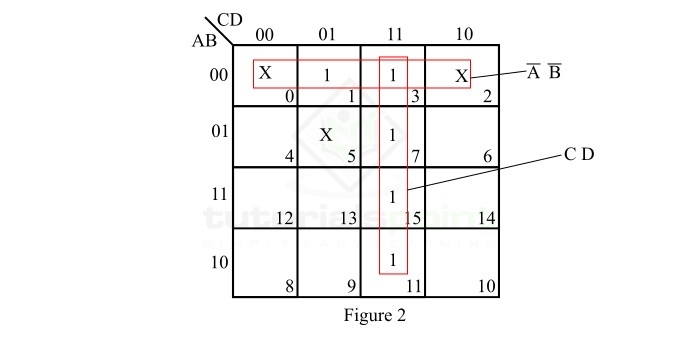
 Data Structure
Data Structure Networking
Networking RDBMS
RDBMS Operating System
Operating System Java
Java MS Excel
MS Excel iOS
iOS HTML
HTML CSS
CSS Android
Android Python
Python C Programming
C Programming C++
C++ C#
C# MongoDB
MongoDB MySQL
MySQL Javascript
Javascript PHP
PHP
- Selected Reading
- UPSC IAS Exams Notes
- Developer's Best Practices
- Questions and Answers
- Effective Resume Writing
- HR Interview Questions
- Computer Glossary
- Who is Who
Minimization of Incompletely Specified Logic Functions
In Boolean or logic algebra, a logic function is a mathematical expression which specifies the relationship between inputs and outputs of a logic circuit. Boolean functions can be classified into two types namely, completely specified logic functions and incompletely specified logic functions.
A completely specified logic function is one whose output is determined or defined for every possible combination of inputs, while a Boolean function whose output value is unspecified for at least one combination of inputs is called incompletely specified logic function.
In an incompletely specified logic function, the combinations of input variables for which the output is not defined are called don't care combinations.
In this article, we will discuss the minimization of incompletely specified logic functions with the help of examples.
Example 1
Minimize the Boolean expression to its minimal form,
$$F\left ( A,B,C,D \right )=\sum m\left ( 0, 3, 7, 8, 9, 10, 11, 15 \right )+d\left ( 2,4 \right )$$
Solution
We can observe that the given Boolean function has two don't cares, i.e. 2 and 4, hence it is an incompletely specified logic function. We can minimize this function using K-Map (Karnaugh Map) minimization technique.
The K-map representation of the given incompletely specified logic function is shown in Figure-1 below.

In the K-Map shown in Figure-1, the reduction is done as per the following steps ?
Step 1 ? There are no isolated 1s.
Step 2 ? The minterm m0 makes four square with minterms m2 (don't care), m8, and m10. Make the four square and read it as $\bar{B}\bar{D}$
Step 3 ? The minterm m3 makes a four square with minterms m7, m11, and m15. Make the four square and read it as $CD$.
Step 4 ? The minterm m8 makes a four square with minterms m9, m10, and m11. Make the four square and read it as $A\bar{B}$.
Step 5 ? Write all the product terms in SOP (Sum of Product) form.
Thus, the minimal SOP expression of the given incompletely specified logic function is,
$$F_{min}=\bar{B}\bar{D}+A\bar{B}+CD$$
Example 2
Minimize the following Boolean expression,
$$F\left ( A,B,C,D \right )=\sum m\left ( 1, 3, 7, 11, 15 \right )+d\left ( 0, 2, 5 \right )$$
Solution
We can observe that the given Boolean function has three don't care minterms. Hence, it is an incompletely specified logic function.
Now, let us use the K-Map reduction technique to minimize this expression to the minimal form. The K-map representation of the given function is shown in Figure-2.

In the K-map shown in Figure-2, the minimization of the incompletely specified function is done as per the following steps ?
Step 1 ? There are no isolated 1s.
Step 2 ? The minterm m1 forms a four square with minterms m0 (don't care), m2 (don't care), and m3. Make this four square and read it as $\bar{A}\bar{B}$.
Step 3 ? The minterm m7 makes a four square with minterms m7, m11, and m15. Make this four square and read it as $CD$.
Step 4 ? Write all the product terms in SOP form.
So, the minimal Boolean expression of the given incompletely specified logic function is,
$$F_{min}=\bar{A}\bar{B}+CD$$
This is all about the minimization of incompletely specified logic functions in Boolean algebra.

